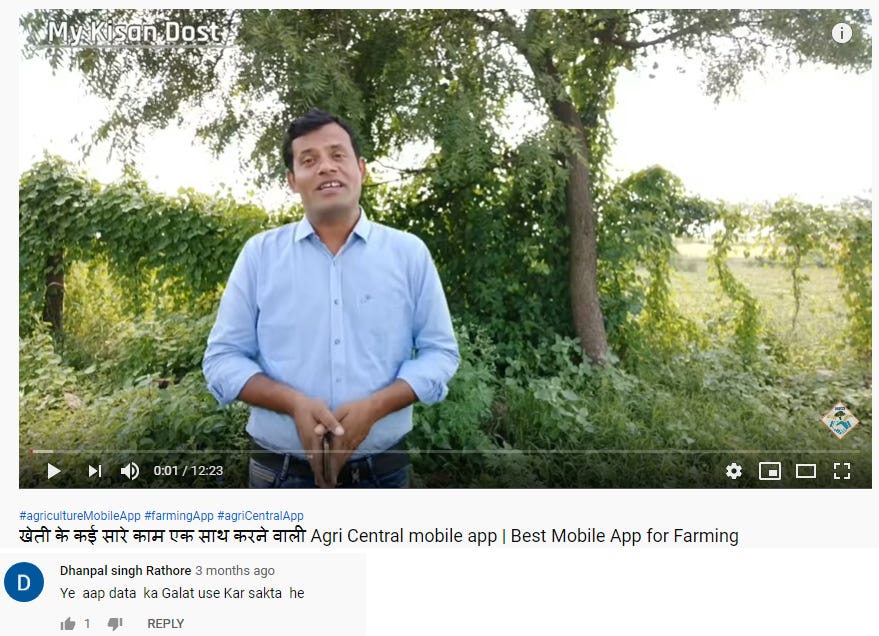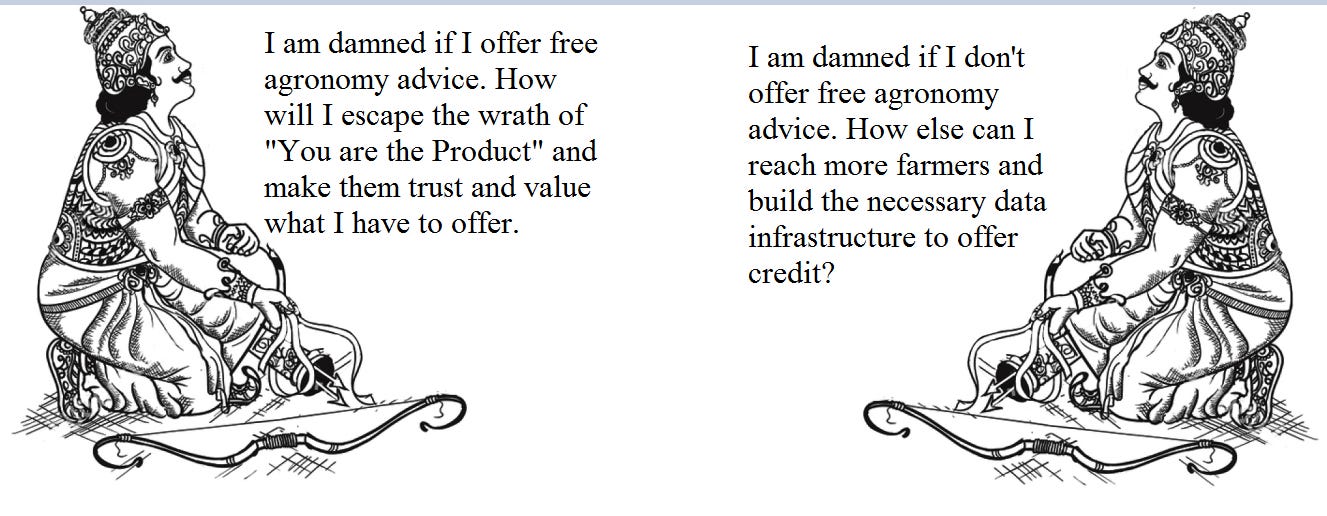3 Lessons on Digital Agronomy from the Department of the Bleeding Obvious.
Are you a late entrant in the agri-input retailing? Do you want to up the game? Read On.
Let's face the truth.
When you do consulting work, whether you like it or not, you belong to the department of the bleeding obvious. No matter how many times you hear sick jokes about stealing watch to tell time, your dharma is to show the uncomfortable mirror and point out the obvious which wasn't obvious until that moment.
As someone deep in the #Agtech woods, I have been observing the steady growth of platforms which offer agronomy advice to Indian farmers in all forms and bundles. I want to separate the chaff from the wheat and make some observations, which may perhaps be useful for Indian Agtech founders wanting to up their game and also late entrant Agri Input firms wanting to re-imagine the e-commerce game to play their strengths.
I'll start from the obvious to the not so obvious.
Lesson #1: You may be going digital. But, don't forget the humble telephone!
Almost everyone who has had some amount of experience serving Indian farmers and agri-input retailers knows this. Village roads are bad and you can only afford to have in your payroll a limited number of field staff who are juggling multiple field jobs for multiple competing brands to make a living. Field staff have a finite time in an eight-hour working day to drive their Honda/Pulsar bikes and complain to anyone with a listening ear about numbing butt and backaches.
I say this with a lot of respect and empathy. I have sat behind their bikes, learned the art of extension services from those road warriors and the amount of stress they go through to manage their sales/marketing quotas is immense.
Amidst all this, do you honestly expect them to build real relationship with farmers?
Your first point of contact with your customer is best done through telephone.
Whether you offer spraying services or agricultural credit or agronomy advice, you are better off designing your customer on-boarding workflow with a missed call or a KPO service which can trigger the event and initiate the first transaction with an adequate amount of routing intelligence in your CRM system.
Don't misread my advice.
Please have field staff in your payroll. You need them for sure! Hire some smart growth hacker ninjas and do the right SEO/digital marketing thing that will work in a regional language search engine context. Pay Youtube Kisan farmers like Santosh Jadhav (who runs Indian Farmer Channel) to be Paid Influencers of your product and promote your latest digital agronomy offering.
But, don't forget the humble telephone!
In other words, as my wise friend Anil Hanegave says, go the hybrid way in your GTM- Go-To-Market- approach.
Lesson #2: Please don't treat the Indian Farmer as the Product!
By now, you know the old saying, don't you?
If you're not paying for the product, you are the product
Indian farmers are smart. They may not use terms like "digital colonialism" as Mukeshbhai did to piggyback Jio on the growing surge of nationalism and place a check in Jio's chess game against Amazon. Indian farmers are wise enough to smell the suspicious fish when they are offered something for free!
You don't believe me? Look at what Dhanpal Singh Rathore ji has to say in a Farmer Influencer video put up by My Kisan Dost Channel for Olam's AgriCentral App.

Don't get me wrong.
I am sharing this with no malafide intentions to smear Agricentral or the team behind this. (Siddharth is a good friend and I have spoken to him once when he was perhaps deliberating about building platforms for farmers). Those who've read me know that I am not the type to make any unctuous moral judgement.
I am not making any assumptions either about Olam's team and their intentions behind launching Agri Central. I picked this snippet because it was the first thing that caught my eye when I was checking out Agri Central and the buzz around it.
You may rightfully argue with me.
Why even think through this tough nut challenge when there are so many complex implementation challenges to build a reliable agronomy service that works for Indian farmers in the first place?
Sure, it makes sense especially when Indian farmers have bigger livelihood concerns to worry about and not be bothered about their app data usage, unlike their western counterparts who have become quite sensitive about this topic.
But, tell me one thing.
Haven't we already seen how this game played out with all the mess Facebook is going through every single day? Why lose out on an opportunity to create a powerful differentiation in the marketplace through unambiguous transparency about data usage?
For all our glitzy talk about reclaiming our data sovereignty, why do we end up creating Terms and Conditions page in which most agritech players in the market resemble each other more or less when it comes to their data policy?
Here is an exercise for you: Spot the difference between AgriCentral and Agrostar and BharatAgri.
We may employ third-party companies and individuals due to the following reasons: To facilitate our service To provide the service on our behalf To perform Service-related services To assist us in analyzing how our Service is used We want to inform users of this Service that these third parties have access to your Personal Information. The reason is to perform the tasks assigned to them on our behalf. However, they are obligated not to disclose or use the information for any other purpose.
We may employ third-party companies and individuals due to the following reasons: To facilitate our Service; To provide the Service on our behalf; To perform Service-related services; or To assist us in analyzing how our Service is used. We want to inform users of this Service that these third parties have access to your Personal Information. The reason is to perform the tasks assigned to them on our behalf. However, they are obligated not to disclose or use the information for any other purpose.
The Website and App may be upgraded from time to time with new features and services. The User agrees that AgroStar may collate, compile, archive use, transfer, create databases out of or otherwise deal with User’s personal data and use any part of it: (a) as reasonably necessary provide Service; (b) Service improvement and development of new products and/or services; (c) to inform and/or get in touch with Users about the availability of or engage in direct marketing efforts for newer products and/or services or AgroStar or the suppliers or counter-parties (and for that purpose share Client or User’s personal data with those third parties), unless the User has in each case opted out of receiving such communications.
At least, Agri Central has been honest enough to admit that they used privacy policy template as evident in the last line of their Privacy policy page.

Perhaps, I am being naive, nitpicking too early and not focusing on real, hard questions like offering farm credit with fewer KYC requirements or the art of managing operating leverage while doing e-commerce business operations in a warehouse inventory model.
Perhaps, the market hasn't evolved to build the necessary digital infrastructure to bring data sovereignty at scale in rural regions. Blockchain is the obvious solution in such contexts. Such experiments are shown to work in neighbouring countries like Indonesia. I have been talking to ICRISAT and Research Organizations like CGIAR have been emphasizing on the need to have F.A.I.R data principles in place and have even built platforms like Gardian to make open farm data a commercial possibility.
Hara Ag from Indonesia has been able to offer a digital identity to small farmers, hashed on a blockchain, based on the existing paper ID documents of the farmers. It has not been a smooth ride for them, as Hara's CTO has been candid enough to admit.
But isn't that why we are in Agtech in the first place? What more do we need than a challenge worth pursuing?
Lesson #3: Acknowledge the Dharmasankata (double bind) in going with free agronomy advice business model.
If you've understood the picture I have put together so far, you would understand that this is a classic dharmasankata situation.
Regular readers of my blog would know my proclivity to go deeper into any problem and frame the dharmasankata that lies 6 inches beneath it. I earlier pointed it out for Agri Input Manufacturers in Channel Management and also at a macro level, for Digital Agriculture at large.
If I put myself in the shoes of an Agritech founder deliberating over free agronomy advice business model, I am stuck in a dharmasankata, much like Arjuna faced when he was standing in front of the battlefield in Mahabharata.

If you are the Arjuna standing on the battlefield with this dharmasankata, what will you do?

